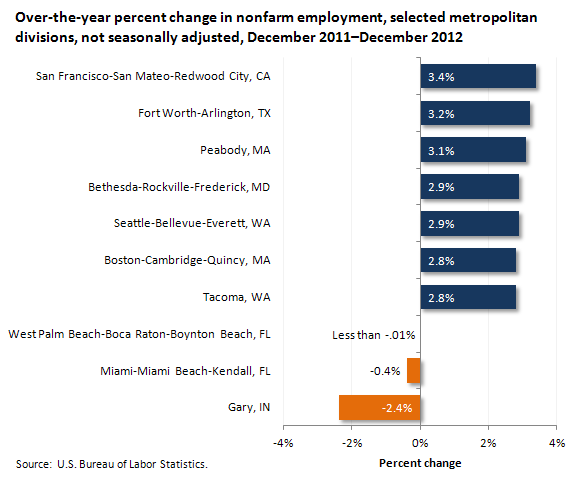An official website of the United States government
 United States Department of Labor
United States Department of Labor
In December 2012, 29 of the 32 metropolitan divisions for which employment data are available reported over-the-year employment gains, while 3 reported losses.

| Metropolitan division | Percent change (p) |
|---|---|
San Francisco-San Mateo-Redwood City, California | 3.4 |
Fort Worth-Arlington, Texas | 3.2 |
Peabody, Massachusetts | 3.1 |
Seattle-Bellevue-Everett, Washington | 2.9 |
Bethesda-Rockville-Frederick, Maryland | 2.9 |
Tacoma, Washington | 2.8 |
Boston-Cambridge-Quincy, Massachusetts | 2.8 |
West Palm Beach-Boca Raton-Boynton Beach, Florida | Less than -.01 |
Miami-Miami Beach-Kendall, Florida | -0.4 |
Gary, Indiana | -2.4 |
Footnotes: | |
From December 2011 to December 2012, the largest over-the-year percentage increase in employment among the metropolitan divisions was reported in San Francisco-San Mateo-Redwood City, California (+3.4 percent), followed by Fort Worth-Arlington, Texas (+3.2 percent), and Peabody, Massachusetts (+3.1 percent).
In December 2012, three metropolitan divisions reported an over-the-year percentage decrease in employment: Gary, Indiana (−2.4 percent), Miami-Miami Beach-Kendall, Florida (−0.4 percent), and West Palm Beach-Boca Raton-Boynton Beach, Florida (Less than −0.01 percent).
These metropolitan area data are from the Current Employment Statistics (State and Area) program; these data are not seasonally adjusted. Data for the most recent month are preliminary and subject to revision. Metropolitan divisions are essentially separately identifiable employment centers within a metropolitan area. To learn more, see "Metropolitan Area Employment and Unemployment — December 2012" (HTML) (PDF), news release USDL-13-0142.
Bureau of Labor Statistics, U.S. Department of Labor, The Economics Daily, Metropolitan division employment, December 2012 at https://www.bls.gov/opub/ted/2013/ted_20130131.htm (visited December 21, 2025).

